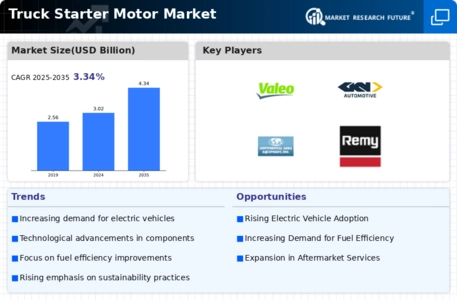Rising Demand for Heavy-Duty Trucks
The Truck Starter Motor Market is significantly influenced by the rising demand for heavy-duty trucks across various sectors, including construction, logistics, and agriculture. As economies expand, the need for robust transportation solutions increases, driving the production of heavy-duty vehicles. According to recent data, the heavy-duty truck segment is projected to grow at a compound annual growth rate of approximately 4.5% over the next few years. This growth directly correlates with the demand for reliable starter motors, as these vehicles require high-performance components to ensure operational efficiency. Consequently, manufacturers in the Truck Starter Motor Market are likely to focus on producing durable and efficient starter motors to meet this escalating demand.
Growth of E-commerce and Logistics Sector
The Truck Starter Motor Market is benefiting from the rapid growth of the e-commerce and logistics sector. As online shopping becomes increasingly prevalent, the demand for efficient transportation solutions rises, leading to an uptick in heavy-duty truck production. This trend is particularly evident in urban areas, where logistics companies are expanding their fleets to meet consumer expectations for fast delivery. Data indicates that the logistics sector is expected to grow by over 6% annually, which directly impacts the Truck Starter Motor Market. Consequently, manufacturers are likely to focus on producing starter motors that can withstand the demands of frequent use and varying operational conditions, thereby enhancing their market position.
Regulatory Compliance and Emission Standards
The Truck Starter Motor Market is also shaped by stringent regulatory compliance and emission standards imposed by governments worldwide. These regulations aim to reduce the environmental impact of heavy-duty vehicles, prompting manufacturers to innovate and adapt their products accordingly. For instance, the introduction of stricter emissions standards has led to the development of starter motors that are compatible with advanced engine technologies, such as those utilizing alternative fuels. This shift not only enhances the performance of trucks but also aligns with sustainability goals. As regulations continue to evolve, the Truck Starter Motor Market may witness a surge in demand for compliant and efficient starter motors, compelling manufacturers to invest in cleaner technologies.
Technological Advancements in Starter Motors
The Truck Starter Motor Market is experiencing a notable shift due to rapid technological advancements. Innovations such as improved materials and designs enhance the efficiency and reliability of starter motors. For instance, the integration of brushless technology is becoming more prevalent, which reduces wear and increases lifespan. Furthermore, advancements in electronic control systems allow for better performance in extreme conditions, which is crucial for heavy-duty trucks. As manufacturers adopt these technologies, the market is likely to see a rise in demand for high-performance starter motors. This trend suggests that companies investing in research and development may gain a competitive edge, potentially leading to increased market share in the Truck Starter Motor Market.
Increased Focus on Vehicle Maintenance and Reliability
The Truck Starter Motor Market is witnessing an increased focus on vehicle maintenance and reliability among fleet operators. As competition intensifies, companies are prioritizing the longevity and performance of their vehicles to minimize downtime and maintenance costs. This trend has led to a growing preference for high-quality starter motors that offer enhanced durability and reliability. Fleet operators are increasingly investing in advanced starter motor technologies that promise better performance under challenging conditions. This shift suggests that the Truck Starter Motor Market may see a rise in demand for products that not only meet but exceed traditional performance standards, thereby fostering a more competitive landscape.


















Leave a Comment